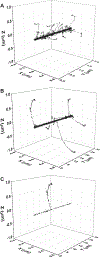Ultra-High Dose-Rate, Pulsed (FLASH) Radiotherapy with Carbon Ions: Generation of Early, Transient, Highly Oxygenated Conditions in the Tumor Environment
- PMID: 32853343
- PMCID: PMC7856087
- DOI: 10.1667/RADE-19-00015.1
Ultra-High Dose-Rate, Pulsed (FLASH) Radiotherapy with Carbon Ions: Generation of Early, Transient, Highly Oxygenated Conditions in the Tumor Environment
Abstract
It is well known that molecular oxygen is a product of the radiolysis of water with high-linear energy transfer (LET) radiation, which is distinct from low-LET radiation wherein O2 radiolytic yield is negligible. Since O2 is a powerful radiosensitizer, this fact is of practical relevance in cancer therapy with energetic heavy ions, such as carbon ions. It has recently been discovered that large doses of ionizing radiation delivered to tumors at very high dose rates (i.e., in a few milliseconds) have remarkable benefits in sparing healthy tissue while preserving anti-tumor activity compared to radiotherapy delivered at conventional, lower dose rates. This new method is called "FLASH radiotherapy" and has been tested using low-LET radiation (i.e., electrons and photons) in various pre-clinical studies and recently in a human patient. Although the exact mechanism(s) underlying FLASH are still unclear, it has been suggested that radiation delivered at high dose rates spares normal tissue via oxygen depletion. In addition, heavy-ion radiation achieves tumor control with reduced normal tissue toxicity due to its favorable physical depth-dose profile and increased radiobiological effectiveness in the Bragg peak region. To date, however, biological research with energetic heavy ions delivered at ultra-high dose rates has not been performed and it is not known whether heavy ions are suitable for FLASH radiotherapy. Here we present the additive or even synergistic advantages of integrating the FLASH dose rates into carbon-ion therapy. These benefits result from the ability of heavy ions at high LET to generate an oxygenated microenvironment around their track due to the occurrence of multiple (mainly double) ionization of water. This oxygen is abundant immediately in the tumor region where the LET of the carbon ions is very high, near the end of the carbon-ion path (i.e., in the Bragg peak region). In contrast, in the "plateau" region of the depth-dose distribution of ions (i.e., in the normal tissue region), in which the LET is significantly lower, this generation of molecular oxygen is insignificant. Under FLASH irradiation, it is shown that this early generation of O2 extends evenly over the entire irradiated tumor volume, with concentrations estimated to be several orders of magnitude higher than the oxygen levels present in hypoxic tumor cells. Theoretically, these results indicate that FLASH radiotherapy using carbon ions would have a markedly improved therapeutic ratio with greater toxicity in the tumor due to the generation of oxygen at the spread-out Bragg peak.
©2020 by Radiation Research Society. All rights of reproduction in any form reserved.
Figures




References
-
- Bernier J, Hall JE, Giaccia A. Radiation oncology: A century of achievements. Nat Rev Cancer 2004; 4:737–47. - PubMed
-
- Favaudon V, Caplier L, Monceau V, Pouzoulet F, Sayarath M, Fouillade C, et al. Ultrahigh dose-rate FLASH irradiation increases the differential response between normal and tumor tissue in mice. Sci Transl Med 2014; 6:245ra93. - PubMed
-
- Favaudon V, Fouillade C, Vozenin M-C. Ultrahigh dose-rate, “flash” irradiation minimizes the side-effects of radiotherapy. Cancer Radiother 2015; 19:526–31. - PubMed
-
- Favaudon V Flash radiotherapy at very high dose-rate: A brief account of the current situation. Cancer Radiother 2019; 23:674–6. - PubMed
-
- Hall EJ. Radiation dose-rate: A factor of importance in radiobiology and radiotherapy. Br J Radiol 1972; 45:81–97. - PubMed
Publication types
MeSH terms
Substances
Grants and funding
LinkOut - more resources
Full Text Sources
Other Literature Sources
Medical

